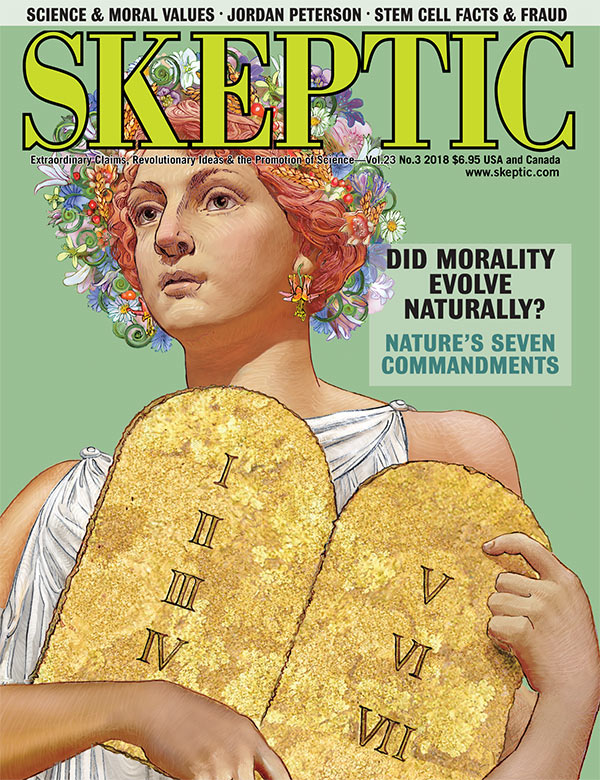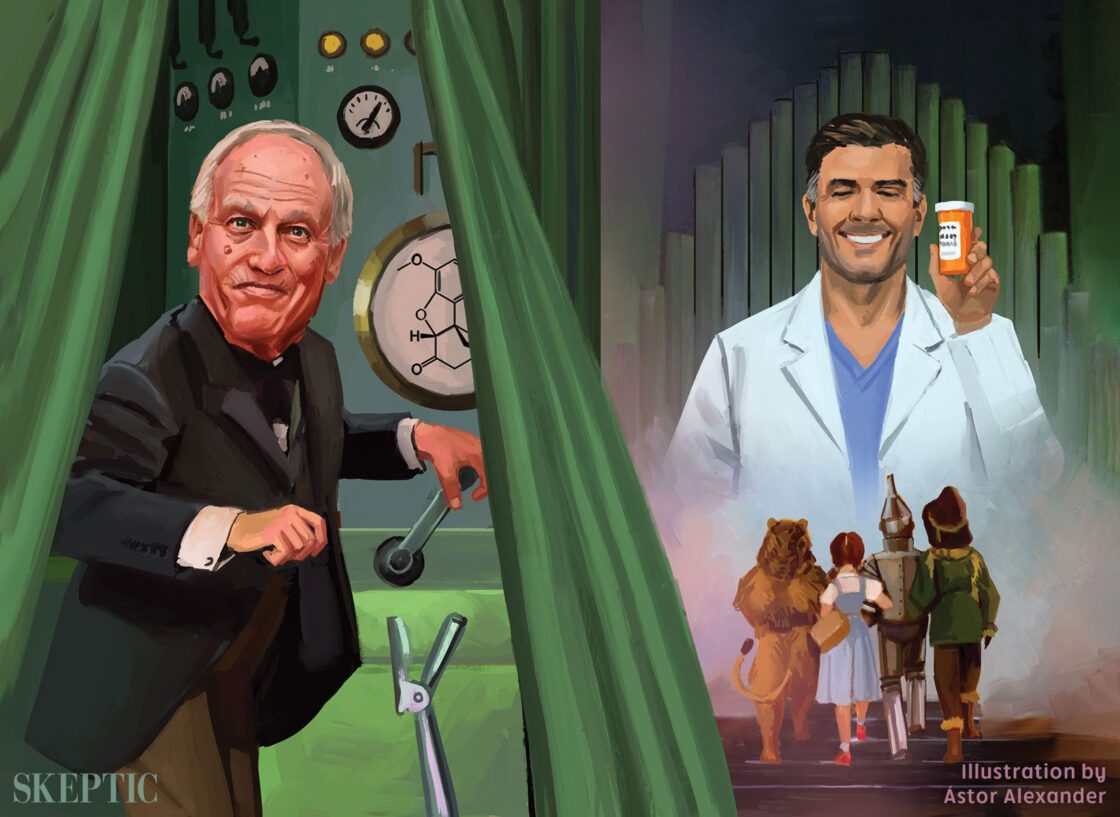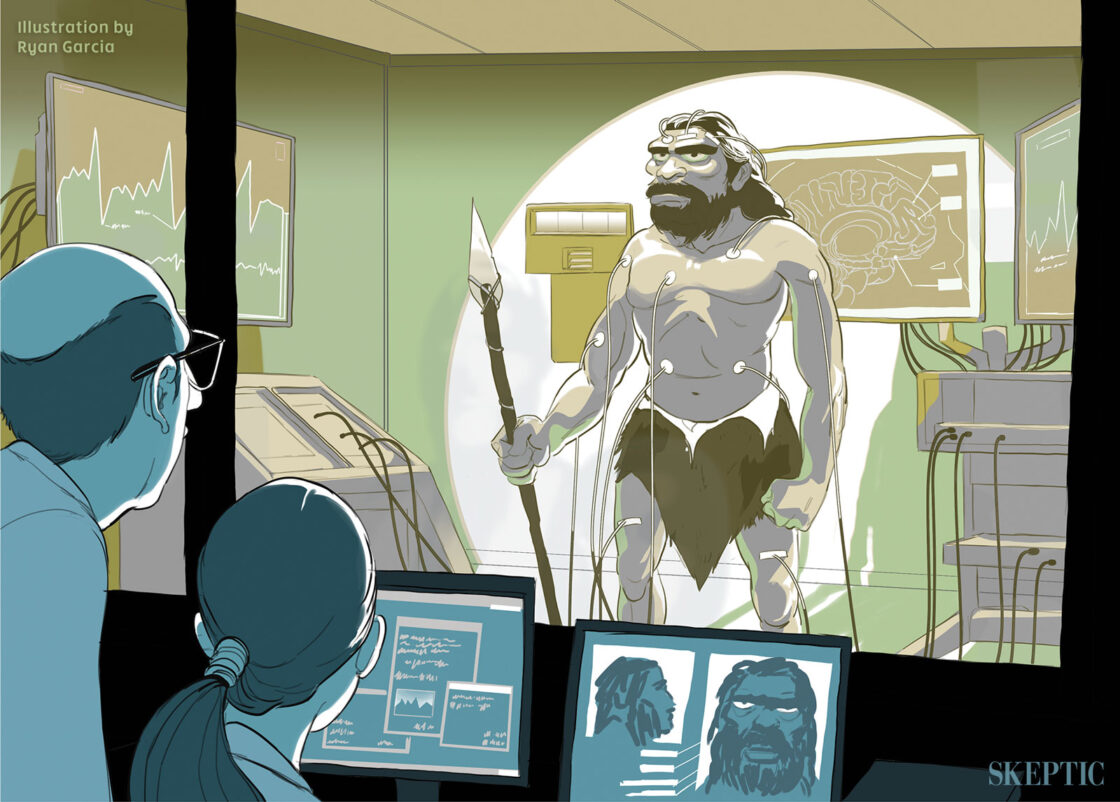When I was a lad one of the most popular television series of the early 1960s was the western Have Gun—Will Travel, staring Richard Boone in the title role as Paladin, a mercenary gunslinger whose name echoes the knights in Charlemagne’s court (he was the “knight without armor”). The chivalrous Paladin wore custom-made suits, was schooled in philosophy, classical literature, opera, piano, poker, and chess, and was preternaturally gifted in fighting skills from Chinese martial arts and western fisticuffs to swordsmanship and firearms. Paladin usually tried to resolve his clients’ problems nonviolently, but as signaled on his title business card embossed (see image at top of this page) with the knight chess piece (also emblazoned on his holster), more often than not he relied on his custom-made Colt .45 single-action revolver with a unique rifled barrel for increased accuracy.1 “With this gun, I could have stopped murder tonight,” Paladin reflects in an early episode. “In all my life I’ve only seen a dozen real killers, but I’ve seen ten thousand people that would stand by and let it happen. Which is the greater evil?”
The Paladin Archetype
Paladin is an archetype—a recurring symbol, a prototype, a Platonic ideal—in this case representing the hero myth (in black-and-white TV simplicity no less) that may well capture the Jordan Peterson Phenomenon (JPP), which has arisen around the Canadian clinical psychologist cum public intellectual who has embraced the Paladin archetype of the hero in Paladin-style dress, manners, and erudition. Given his professed lifelong goal of understanding human evil—particularly that of 20th century Fascism and Communism—Paladin’s greater evil question above may well have been asked by Peterson, who has for the past several years been cajoling his fans to stand up instead of stand by. More on this below.
I was first introduced to Peterson on Joe Rogan’s podcast in 2016,2 shortly after I first appeared on the show,3 when podcast numbers were surpassing those of even the most popular cable news and talk shows, launching what would later become known as the Intellectual Dark Web, of which I am a member.4 Peterson has his own podcast as well,5 on which I appeared as a guest in early 2018 in conjunction with the publication of my book Heavens on Earth,6 just a few months before his 12 Rules for Life was published, launching its author into the cultural stratosphere.
This was a propitious time to enter the public arena, when alternative and social media gave many people a platform hitherto unavailable to all but a handful of noted academic scholars and scientists. Where once only Kenneth Clark (Civilization), Jacob Bronowski (The Ascent of Man), and Carl Sagan (Cosmos) were able to land a documentary series on one of only four networks (PBS), today anyone with a computer, an Internet connection, and a few apps can become a media sensation. As Peterson’s YouTube subscriber list exceeded a million people, and many millions more tuned in to hear each appearance on various popular podcasts, Peterson refined his talking points and wove them into a narrative that seem to resonate with a great many people. I wanted to find out why, so in late spring of 2018 we determined that Skeptic magazine should look into Peterson— not just his claims, such as doling out self-help advice in podcasts and public talks or explaining the meaning of myths and biblical stories in YouTube videos—but the seemingly insatiable media coverage and public consumption of everything he says and does. I arranged for my contributing editor Stephen Beckner (see his accompanying article in this issue) and I to attend Peterson’s public performance at the 1800- seat Fred Kavli Theater in Thousand Oaks, California (sold out, as most of his events are), and he was generous enough to spend an hour in the green room talking informally with us about his ideas and all that has unfolded over the past two years (while signing 12 Rules for Life posters). Our goal in this inquiry is not to “debunk” Peterson, which many readers have asked us to do as if it were a given that he’s a quack selling snake-oil, but rather to analyze his claims and the JPP in the spirit of Skeptic’s motto from the Dutch philosopher Baruch Spinoza: “I have made a ceaseless effort not to ridicule, not to bewail, not to scorn human actions, but to understand them.”
Jordan Peterson, Bill C-16, and Freedom of Speech
Before 2016 Jordan Peterson was indistinguishable from any other relatively successful academic with a respectable scholarly pedigree: B.A. in political science from the University of Alberta (1982), B.A. in psychology from the same institution (1984), Ph.D. in clinical psychology from McGill University (1991), postdoc at McGill’s Douglas Hospital (1992–1993), assistant and associate professorships at Harvard University in the psychology department (1993–1998), full tenured professorship at the University of Toronto (1999 to present), private clinical practice in Toronto, and a scholarly book by a reputable publishing house (Routledge). This ordinary career path turned extraordinary in 2016 when the controversial Bill C-16, a federal amendment to the Canadian Human Rights Act and Criminal Code, was passed, “to protect individuals from discrimination within the sphere of federal jurisdiction and from being the targets of hate propaganda, as a consequence of their gender identity or their gender expression.”7 That sounds reasonable enough: if we’re going to protect people from discrimination based on race, age, sex, and religion, why not gender identity or expression as well? Who would disagree with this clause in the bill?
[A]ll individuals should have an opportunity equal with other individuals to make for themselves the lives that they are able and wish to have and to have their needs accommodated, consistent with their duties and obligations as members of society, without being hindered in or prevented from doing so by discriminatory practices based on race, national or ethnic origin, colour, religion, age, sex, sexual orientation, marital status, family status, disability or conviction for an offence for which a pardon has been granted or in respect of which a record suspension has been ordered.
To me this reads like another step on the moral arc bending toward justice. But in a series of YouTube videos Peterson outlined his concerns (dread really) that Bill C-16 could turn into “compelled speech” that, if not obeyed, could land one in jail for not addressing someone by their preferred pronoun (zie, xem, hir, ve, xe, xyr…).8 Peterson went on record stating, “I’m not using the words that other people require me to use, especially if they’re made up by radical left-wing ideologues. And that’s that.”9 Even more emphatically, he told a television audience, “If they fine me, I won’t pay it. If they put me in jail, I’ll go on a hunger strike.”10 The image of a Canadian psychology professor on a hunger strike over gender pronouns is a little hard to equate with Gandhi’s emaciating efforts to break free his country from British rule, but it’s a sign of moral progress that we’ve shifted from condemning colonization to protesting pronouns.

Jordan Peterson autographs copies of his 12 Rules for Life poster in the greenroom before his lecture.
To his credit, Peterson has said that if he were asked to address someone by a preferred pronoun he might oblige him or her (or zhe or zher), assuming it was asked for the right reasons; i.e., not for political motives or a Borat-like gotcha.11 Fair enough. When I was an undergraduate at Pepperdine University I had a roommate who changed his name from Duane to D’Artagnan (the 4th member of the Three Musketeers), after which he respectfully asked us to address him by his new name—eventually shortened to D’Art—which we did (after a few Spock-like raised eyebrows). But that’s a personal matter. It is an entirely different issue for the government to legislate speech, especially because the law is backed by violence or the threat thereof (as in Max Weber’s classic definition of the state as having a “monopoly of the legitimate use of physical force”). Threatening people with physical violence for refusing to address someone by their preferred pronoun does smack of anti-Enlightenment illiberalism, government overreach, and even tyranny.
Would Bill C-16 result in Canadian professors (or anyone else) being fined, jailed (and, presumably, force-fed) at the point of a gun for not using preferred gender pronouns? Is it, as Peterson described it in an Opinion Editorial in the National Post, “frighteningly similar to the Marxist doctrines that killed at least 100 million people in the 20th century”?12 I don’t think so. As I read the Bill, as in most legislation there is much room for interpretation and many steps between legal language and the Gulag archipelago. I don’t think Peterson was ever in danger of losing his job, much less residing in the Grey Bar Hotel.
Still, given the number of professors who have faced Title IX inquiries, been shamed on campus and on social media over political peccadillos, or even lost employment over ideological conflicts, Peterson’s stated concerns about job security at the University of Toronto (which helped propel his Patreon account into numbers only one-percenters could identify with) are not entirely without precedent. The highly publicized ousting of the biologists Bret Weinstein and Heather Heying at Evergreen University is the most blatant example, and many more have been documented by Laura Kipnis in her 2017 book Unwanted Advances and by Greg Lukianoff and Jonathan Haidt in their 2018 book The Coddling of the American Mind. There is no doubt that many college campuses today are being swept up by an East German Stasilike climate of ideological conformity, political suppression, speech censorship, interpersonal suspicion, and preemptive denunciation—denouncing others before they denounce you—leading to the unhealthiest climate for free speech since 1950’s McCarthyism. So when Jordan Peterson said “enough” to Bill C-16, it was symbolic of this larger problem, and he became an archetypal hero willing to stand up to this perceived evil. And just as Peterson’s critics were accusing him of exaggerating the dangers of the Bill, in 2017 a graduate student at Wilfrid Laurier University in Canada named Lindsay Shepherd was formally censured by her superiors for merely showing her class a video clip of Peterson debating Bill C-16 on a television news program, accusing her of creating a “toxic climate” and, in accordance to Godwin’s Rule, comparing Peterson’s words to a “speech by Hitler.”13
At this point Peterson would have been fully justified in pronouncing “I rest my case,” and anyone who would join a Fair Play for Political Correctness Committee would be seriously out of touch with reality.
The Archetypal Theory of Truth
In an episode of Star Trek, The Next Generation titled “Chain of Command,”14 Captain Jean-Luc Picard is captured and tortured by a Cardassian interrogation expert who has implanted a pain generating device in Picard’s chest that can be turned on with the push of a button, which will end if the Enterprise Captain will reveal the Federation’s plans for disputed space. Throughout days of agonizing torture Picard is confronted with four blindingly bright lights and told there are five. The torturer knows that he can break Picard if he can get him to confess to the false number. Throughout the ordeal the indefatigable captain grunts through the pain that “there are four…four lights,” only to confess to the ship’s counselor at the end of the episode that he actually came to believe that there were five lights.
How many lights were there, really? Four, of course, but I’m not at all sure Jordan Peterson would agree, given his preference for a pragmatic interpretation of truth, which holds that what works for an observer in a given context is what is true. In two excruciating podcast episodes lasting over four hours total,15 the philosophical realist Sam Harris could not convince the philosophical pragmatist Peterson that there is, for example, a correct order of U.S. Presidents if, in Sam’s thought experiment, terrorists told their captive that disaster could be averted if the correct order of U.S. Presidents were recited…with this wrinkle: the terrorists have a mistaken order of the Presidency, so their hostage would need to enumerate the wrong sequence to forestall the looming calamity. Surely Peterson would agree that there really is a correct temporal sequence of Presidents and that the terrorists are simply mistaken (and their prisoner knows he’s regurgitating an erroneous list), but no! Instead, Peterson waxed archetypal, calling religious claims, mythological stories, and literary masterpieces “meta-true” and “more true than scientific truth” inasmuch as they are mediated by socio-political and cultural factors related to our Darwinian need to survive and reproduce. There is no “truly independent” truth, he says, only useful or not useful truths pertaining to our evolutionary needs. The use-value of a claim at a particular time and place is what makes it true.
Peterson’s theory—call it the Archetype Theory of Truth (ATT)—is very much in line with that of the cognitive psychologist Donald Hoffman’s Interface Theory of Perception (ITP), which holds that percepts about the world are a species-specific user interface that directs behavior toward survival and reproduction, not truth.16 Objects in nature are like desktop icons, Hoffman analogizes, and the physical environment is like the desktop. Our senses form a Biological User Interface (BUI)—analogous to a computer’s Graphical User Interface (GUI)—between our brains and the outside world, transducing physical stimuli such as photons of light into neural impulses processed by the visual cortex as things in the environment. GUIs and BUIs are useful because you don’t need to know what is inside computers and brains. You just need to know how to interact with the interface well enough to accomplish your task. Adaptive function, not veridical perception, is what is important to evolution.

Michael Shermer (left) and Jordan Peterson (right) during a podcast
I’m skeptical of Peterson’s ATT for the same reasons I am of ITP. My refutation of ITP in Scientific American17applies to Peterson’s ATT:
First, how could a more accurate perception of reality not be adaptive? Hoffman’s answer is that evolution gave us an interface to hide the underlying reality because, for example, you don’t need to know how neurons create images of snakes; you just need to jump out of the way of the snake icon. But how did the icon come to look like a snake in the first place? Natural Selection. And why did some nonpoisonous snakes evolve to mimic poisonous species? Because predators avoid real poisonous snakes. Mimicry only works if there’s an objective reality to mimic.
Hoffman claims, “A rock is an interface icon, not a constituent of objective reality.” But a real rock chipped into an arrow point and thrown at a four-legged meal really works even if you don’t know physics and calculus. Is that not veridical perception with adaptive significance?
Hoffman says perception is species specific and that we should take predators seriously, but not literally. Yes, a dolphin’s icon for “shark” no doubt looks different than a human’s, but there really are sharks and they really do have powerful tails on one end and a mouthful of teeth on the other end, and that is true no matter how your sensory system works.
This repudiation of Hoffman’s ITP (and, thereby, Peterson’s ATT) is an expression of the correspondence theory of truth, which according to the Stanford Encyclopedia of Philosophy (SEP),18 “is the view that truth is correspondence to, or with, a fact” and “more broadly to any view explicitly embracing the idea that truth consists in a relation to reality.” ITP and ATT are also refuted by scientific realism, which the SEP characterizes as “a commitment to the idea that our best theories have a certain epistemic status: they yield knowledge of aspects of the world, including unobservable aspects,”19 and ontological realism, or the belief that there is a world external to human minds, and that this world is knowable. The vast majority of professional philosophers trained to think about truth embrace these positions, as revealed in a 2009 survey of 3,226 philosophy professors and grad students asked to weigh in on 30 different subjects of concern in their field, from free will and God to knowledge and mind.20 On the topic of the external world, 81.6 percent accept or lean toward non-skeptical realism, 75.1 percent accept or lean toward scientific realism, and 50.8 percent accept or lean toward the correspondence theory of truth. No matter what beliefs about the world a torturer may evoke in his victim, if there are four lights there cannot be five, and Washington, Adams, Jefferson, Madison, and Monroe were the first five presidents. And that’s that!
Nevertheless, I will grant Jordan his emphasis on the power of literary “truths” to explore deep themes and move people to change their lives. “There is great truth revealed in Dostoevsky, Tolstoy, and Shakespeare,” Peterson proclaims. Of course there is. That’s what makes great literature great. But there’s that word again. Truth. Presumably there were no brothers named Karamozov in 19th century Russia, but whether there were or not is beside the point because Dostoevsky’s The Brothers Karamozov is a novel exploring profound philosophical issues of God, morality, volition, and the human struggles with faith and doubt during a time of social and political upheaval, not a scientific history of Russian modernity. Here truth is symbolic, or archetypal, inasmuch as the characters and plots of a novel reflect a type of reality as the author interprets it, and to that end a new field of Darwinian literary studies has taken root that explores why certain themes appear again and again in fiction in the context of our evolved nature, such as sex, love, jealousy, power, hierarchy, aggression, violence, and murder. If Peterson would be willing to forego his Archetype Theory of Truth, I will agree that literature, myths, and even biblical stories add much value to the understanding of the human condition.
The Architecture of Archetypes
During the hour and a quarter that Jordan and I talked on his podcast he described a recently-published neuroscience paper on the structure of neural cortical columns that shows they’re not randomly connected to other neurons in the brain, “and what this scan shows is an underlying superhighway of built-in connections so that the columns themselves can wire into the already existing superhighways, so it was like there was an underlying architecture that was highly probable that it would manifest itself, and I thought ‘well that looks like the neuro-architecture of something like an archetype’.” To which I replied, “Um…maybe.”21
Peterson’s magnum opus Maps of Meaning, in fact, is subtitled The Architecture of Belief, a 564-page mishmash of evolutionary theory, biology, psychology, philosophy, literature, comparative mythology, theology, the bible, Nietzsche, Dostoevsky, Jung, Freud, and others that may have been more accurately subtitled The Architecture of Archetypes. I undertook listening to the unabridged audio edition read by the author, but the book is so dense and convoluted that I DNF’d after six hours. Perhaps reading it makes more sense, or perhaps there isn’t much sense to be made—at least for my more literalist wired brain—but it’s hard to know what to make of passages like these, which fill page after page, hour after hour…
The Great Mother aborts children, and is the dead fetus; breeds pestilence, and is the plague; she makes of the skull something gruesomely compelling, and is all skulls herself. To unveil her is to risk madness, to gaze over the abyss, to lose the way, to remember the repressed trauma. She is the molestor of children, the golem, the bogey-man, the monster in the swamp, the rotting cadaverous zombie who threatens the living. She is progenitor of the devil, the “strange son of chaos.” She is the serpent, and Eve, the temptress; she is the femme fatale, the insect in the ointment, the hidden cancer, the chronic sickness, the plague of locusts, the cause of drought, the poisoned water. She uses erotic pleasure as bait to keep the world alive and breeding; she is a gothic monster, who feeds on the blood of the living.22
It goes on like this for over 30 hours. As Peterson told the Chronicle of Higher Education: “I don’t think people had any idea what to make of the book, and I still think they don’t.”23 Whew! So it’s not just me.
I had more success with 12 Rules for Life, making it through all 15 hours. Although still too long by half for my tastes, most of the advice Peterson offers resonates reasonably well with the findings of cognitive behavior therapy, as noted by the clinical psychologist Jonathan N. Stea in his assessment (in this issue of Skeptic) of Peterson’s advice: “The potential benefits from understanding and consuming his material can approximate what one can glean from successful psychotherapy. Whether a person wants to mitigate mental health concerns or improve their quality of life, self-help materials can be thought of as the lowest rung on the ladder in a stepped-care model of mental health treatment.” To that end I recommend Jocko Willink’s 2017 book Discipline Equals Freedom and Amy Alkon’s 2018 book Unfuckology: A Field Guide to Living with Guts and Confidence, both of which I’m confident Peterson would endorse given that so many of his rules—such as “stand up straight with your shoulders back,” “compare yourself to who you were yesterday, not to who someone else is today,” and “set your house in perfect order”—are similar to those outlined by Willink and Alkon and supported by the findings of science, such as the value of “small wins” (e.g., make your bed, clean your room) that build confidence for larger challenges that can lead to big wins.
Entropy and Extropy, Chaos and Order
One friend and colleague described Jordan Peterson to me as “one pair of mirrored sunglasses away from being a cult leader.” This is unfair to his audience. The people I met at the Thousand Oaks event were nothing like glaze-eyed Jim Jones followers, nor were they mostly angry young white men as Peterson’s critics repeat like a mantra. As I gazed around the auditorium an informal head count put the gender ratio at roughly 65:35 Male:Female, their ages varying wildly from teenagers to senior citizens, and the evening wasn’t even remotely political (observations that I confirmed about other audiences with Dave Rubin, who has opened for Peterson in dozens of cities). “They’re not coming for a political discussion,” Peterson has said about his audiences. They’re “coming because they’re trying to put themselves together. And there isn’t anything about that that isn’t good.”

This article was originally published in Skeptic magazine 23.3 (2018).
Buy print edition
Buy digital edition
Subscribe to print edition
Subscribe to digital edition
In point of fact, the subtitle of 12 Rules for Life is An Antidote to Chaos, which leads me to a final point on the JPP, namely his worldview, which is well aligned with the reality most people experience and another contributing factor to his popularity. Life can be, in the oft-quoted observation of the political philosopher Thomas Hobbes, “solitary, poor, nasty, brutish, and short.” The ultimate reason for this state of affairs is the Second Law of Thermodynamics, or entropy. Without an outside source (like the sun), energy dissipates, systems run down, warm things turn cold, metal rusts, wood rots, weeds overwhelm gardens, and…bedrooms get cluttered. Entropy decrees that there are more ways for things to be disordered than ordered, so Peterson’s counsel to get your life in order is simpatico with a great many people. As I explained in Heavens on Earth, the Second Law of Thermodynamics leads to the First Law of Life, which is to get your life in order:
If you do nothing, entropy will take its course and you will move toward a higher state of disorder (ultimately causing your demise). So your most basic purpose in life is to combat entropy by doing something extropic—expending energy to survive, reproduce, and flourish. In this sense, evolution granted us a purpose- driven life by dint of the laws of nature.
That a meaningful, purposeful life comes from struggle and challenge against the vicissitudes of nature more than it does a homeostatic balance of extropic pushback against entropy reinforces the point that the Second Law of Thermodynamics is the First Law of Life. We must act in the world. The thermostat is always being adjusted, balance sought but never achieved. There is no Faustian bargain to be made in life. We may strive for immortality while never reaching it, as we may seek utopian bliss while never finding it, for it is the striving and the seeking that matter, not the attainment of the unattainable. We are volitional beings, so the choice to act is ours, and our sense of purpose is defined by reaching for the upper limits of our natural abilities and learned skills, and by facing challenges with courage and conviction.24
Which brings us back to the Paladin Archetype and his ratio of real killers to bystanders who enable evil through inaction (12:10,000). If we include entropy as a form of evil, then as the original conservative Edmund Burke famously said, “The only thing necessary for the triumph of evil is that good men do nothing.”25
Standing up to evil—and to entropy—is an antidote to chaos. ![]()
About the Author
Dr. Michael Shermer is the publisher of Skeptic magazine, a monthly columnist for Scientific American and a presidential fellow at Chapman University. His latest book is Heavens on Earth: The Scientific Search for the Afterlife, Immortality, and Utopia.
References
- https://bit.ly/2uKo5ky
- https://bit.ly/2gIfvt8
- https://bit.ly/2NA4BGm
- https://nyti.ms/2IrkbW4
- https://bit.ly/2p5HVnt
- https://bit.ly/2uCnvoO
- https://bit.ly/2zXoXHw
- https://bit.ly/2dzbIT2
- https://bit.ly/2mSPCvt
- https://bit.ly/2HCY621
- https://bit.ly/2gla1G6
- https://bit.ly/2uWIq5r
- https://bit.ly/2uJ8L7S
- Season 6, Ep. 11, https://bit.ly/2Lg54Ru
- https://bit.ly/2LcrEu9 and https://bit.ly/2sEeTji
- https://bit.ly/2NCFanH
- https://bit.ly/2LFupjO
- https://stanford.io/1SC6oKJ
- https://stanford.io/1nqQciY
- https://bit.ly/1nUaL4L
- At the 58 minute mark here: https://bit.ly/2uCnvoO
- https://amzn.to/2uNmGtu p. 162.
- https://bit.ly/2mSPCvt
- https://amzn.to/2OdFM4e p. 251.
- https://bit.ly/2CYLGk0
This article was published on September 26, 2018.


















I love you, but your sentence about Stephen Beckner should state: Stephen Beckner and me.
nice article, especially like truth relates to fact/ reality. to be a cult leader i imagine you’d want the position at least as much as Caesar wants to be emperor (compared to say Germanicus).
@Alfred I have to question your interpretation of “The Bell Curve”. Sam Harris who I greatly respect has stated that the book was not based on pseudoscience and further that it was equally “against” whites as it concluded that Asians where more intelligent than both of them.
Thanks Michael, now I don’t have to read all that stuff. Appears to be more Nathaniel Brandenish than Carl Jungish.
C-16 only modifies already existing legislation that covered things like ethnic discrimination – nobody has gone to jail for calling someone Japanese Chinese, and nobody since C-16 was passed a year ago has gone to jail for calling someone one pronoun when they want another one.
C-16 puts gender identity into the laws covering ‘hate speech’, but there is a very high barrier to get a conviction – it requires willful promotion of hatred, not simply using the wrong pronoun.
C-16 also modifies the Canadian Human Rights Act – it covers things like workplace harassment, but it only applies to federally regulated workplaces like the armed forces. Universities aren’t covered, but they are under the province of Ontario’s human rights code, which has had gender identity protected for several years, and again, nobody’s been charged for using the wrong pronoun. The provinces don’t actually make criminal law, unlike the states in the USA, but some have argued that Peterson could be called before the Human Rights Tribunal of Ontario, and refuse to pay a fine, and be charged with contempt and go to jail, but this is speculative and not directly connected with C-16.
Lindsay Shepherd wasn’t formally censured , she was just criticized by her supervisors at a meeting that took place after a ‘concern’, which is apparently something different from a formal or informal complaint, about the video was raised by a LGBTQ support group.
“There is no doubt that many college campuses today are being swept up by an East German Stasilike climate of ideological conformity, political suppression, speech censorship, interpersonal suspicion, and preemptive denunciation—denouncing others before they denounce you—leading to the unhealthiest climate for free speech since 1950’s McCarthyism.”
Being skeptic and interested in factual assertions, can you provide comparative examples of East German Stasi persecutions equal to those sweeping across many a US campus?
No doubt prior to making such a claim the author would have made an empirical analysis of both, so should be ready to hand.
Otherwise, it just overwrought if not hysterical hyperbole.
Jordan strikes me as the last gasp hope of intelligent conservatives. Conservative edifices are crumbling. Maybe he’s smart enough to glue them back together again?
Naw. Humpty has fallen.
@Martha: You bring up an interesting point re: women bringing order to the chaos men create. I agree with you. It reminds me of yin/yang philosophy and how important it is to strive for a true balance between the two in everything.
@Martha: Yes, I’ve watched JP’s many YouTube videos and heard his outdated and sexist views on women, to my horror and regret.
His views on Muslims and (other groups & individuals with little/no power in our society) are also scary. His pandering to Jews as “the smartest” while ostensibly affirming the pseudoscience a la The Bell Curve against African-Americans show us his true colors.
He mixes metaphors, he engages in stereotypes, he lectures on topics he knows nothing about, using GRE words and sophistry to confuse and convince. He’ll be a Fox News contributor before we know it!
Most importantly, JP is a clinical psychologist, and from my own studies, awful at it. Why? The first principle of his field is to take the client/patient/person where they are! JP refuses to do so, wanting to call someone by an inappropriate term or pronoun, negating the very fact of their identity and gender! And hiding behind “freedom of speech” when called out.
But in the next moment he wants that person (and all of us) to buy, read, and follow a bunch of highly subjective, often outdated/oldfashioned, pseudo-religious, “truths” that serve an agenda and power structure (under recent intense scrutiny, thankfully) that has benefitted guys like him for centuries. He is just another ideologue alongside Ben Shapiro, Dinesh D’Souza, Pat Buchanan, and others in my lifetime who are terrified of the shift away from power held by caucasian hetero cisgender men.
I write this on the eve of the Judge Kavanaugh hearing regarding alleged past abusive misconduct; we’ll see if we Americans soon end up with a Supreme Court solidified in its own outdated ideology that would truly threaten for all persons the freedom that men like JP supposedly hold so dear.
Martha said, ” I don’t know of anyone who has lost their job in academia for saying “politically incorrect” things.”
Then you didn’t read the article.
“The highly publicized ousting of the biologists Bret Weinstein and Heather Heying at Evergreen University is the most blatant example, and many more have been documented by Laura Kipnis in her 2017 book Unwanted Advances and by Greg Lukianoff and Jonathan Haidt in their 2018 book The Coddling of the American Mind. “
Political correctness has gotten way out of hand. I once made a joke to an audience about werewolves and was promptly accused of being a racist.
An interesting comment on Peterson. But it should be noted that Peterson still has his job and so does Lindsay Shepherd, and the censure was overturned. I don’t know of anyone who has lost their job in academia for saying “politically incorrect” things, and Peterson is not legally trained and kicked up a huge fuss over Bill C-16 that wasn’t warranted, as the writer seems to accept.
But what about Peterson’s trope that women = chaos? Is this not fundamentally a negative view, not to say misogynistic? What help can it possibly be to women? Or to men for that matter? In my experience, women bring order to the chaos that men cause.
@Dan — Amen…
The most important thing I have learned from Jordan Peterson is a way to attempt to have conversations about the subjects that people believe strongly about.
He attempts to point at the things I keep trying to point at.
I think he does it better than I have. But because it appears that he does it better, there is a chance that it is only so because I see him pointing at what I think I am pointing at.
I believe that a lot of the kerfuffle we are seeing right now can be solved if more people extend their hands and say “Hi, my name is [… ]” and finish the shaking of hands.
But some would block this simple expression of showing I am not drawing my weapon by defining that act as ‘assault’.
I have failed in the simple act. There is a balance involve in shaking hands. One must grip firmly enough to demonstrate that one is there. One must not grip so firmly as to overwhelm the other side. There is art. The other side can unbalance the shake by slacking their hand and causing their adversary to be humbled for squishing. There is a defense against this. You can make your hand fully stiff to allow the other side to dictate the squeeze level. Sometimes this defense can get you in trouble also.
Stand with your shoulders back. Shake with confidence. Do not be flustered when you fail to read the shake. Just do better next time.
Thank you again, Dr Mike for another excellent article. Your assessment of the JPP was A-OK (even if it did use too many TLA’s ;)
I have one quibble: your discussion of entropy was not up to your otherwise high standards. Non-Physicists have abused the term Entropy so badly that its meaning in the vernacular is little like its meaning in Thermodynamics. (By analogy think of how the word ‘Theory’ is used in common usage vs what it means in a scientific context).
Saying that entropy is just disorder is awful because it leads to people asking nonsensical questions and then acting as if they are truly profound. An example of such a nonsense question is: Which has more entropy – a bunch of shards of a wine glass that fell and broke OR the exact same arrangement of shards that were carefully broken and placed by an artist?
Entropy is not about physical objects being disordered (to a large extent disorder is in the mind of the beholder) it is about configurations of systems and the statistics of ‘equivalent positions in phase space’ – ie. how many different configurations will yield the same macroscopic state?
If we take this different notion of entropy, and abuse it into addressing the broken wine glass question the answer would depend on how many different possible configurations of shards of glass would constitute a state of broken wine glass vs how many different configurations would be art? The _state_ which can be obtained in more possible different configurations is the state with the greater entropy.
But it is essential to understand that entropy is not about configurations of wine glass shards, or socks on a teenager’s bedroom floor. It is about configurations of systems and how that affects ENERGY. One high energy photon has less entropy than 3 photons whose total energy is equal to it (because there are more ways to divvy up the energy into 3 photons). A bunch of gas containing a certain amount of heat has less entropy if half of the gas contains all of the heat and half is at absolute zero than if the heat is spread throughout all of the gas (because there are more ways the heat energy can be divvied up). Because of the statistics of how many configurations will yield those conditions. Note: I used some very simple examples here because they make the point more quickly – there are many more involved cases of entropy (e.g. some involve multiple forms of energy).
BTW: I apologize for my oversimplification of entropy. Although I (hopefully) made the point that it is vastly different than simply things is disarray, I haven’t done this topic justice. It is a truly wonderful concept… and it leads to many metaphysical notions, like the arrow of time and such.
One last comment: Do not assume that just because you are working hard and giving off heat (IR radiation, heating air) which increases entropy somewhere, that your labors are decreasing the entropy anywhere.
Yay, it’s finally okay to use the word “archetype” in skeptic communities! A few years ago I was just aching for a Peterson to come along and point to a big missing chunk of understanding. To say it in mythopoetic terms: we have not spoken the language of mythos for so long that we almost forgot it exists. We now mostly speak logos, and misinterpret mythos-inspired texts through its literalizing lens. Most people never introspect enough to realize how fundamental metaphor is to every thought.
Despite all his flawed reasonings, Peterson has re-awakened both theists and atheists to this reality. This should soften both sides in the long-term if people can keep up the dialogue.